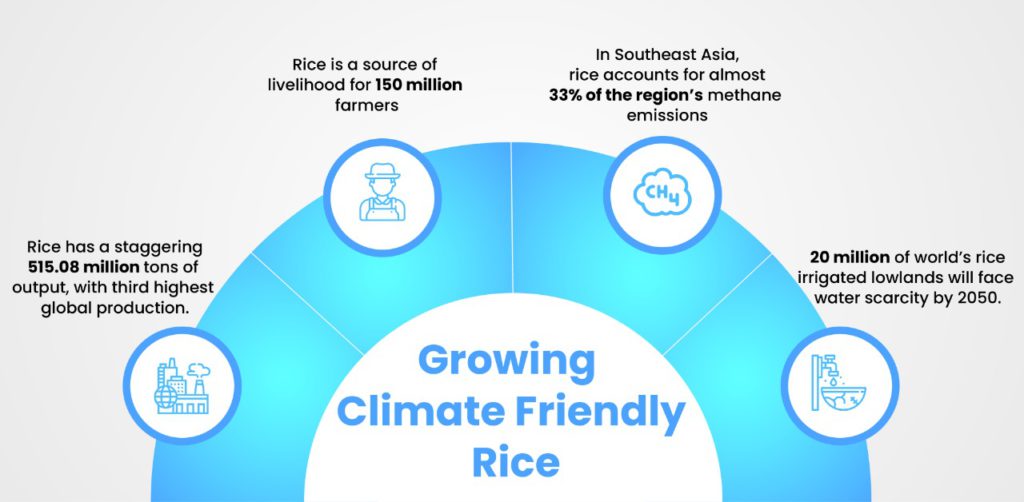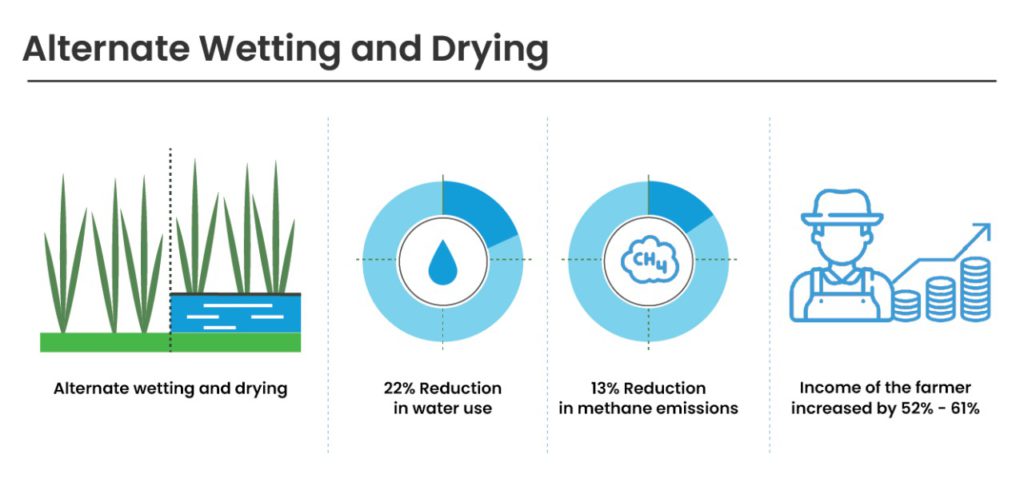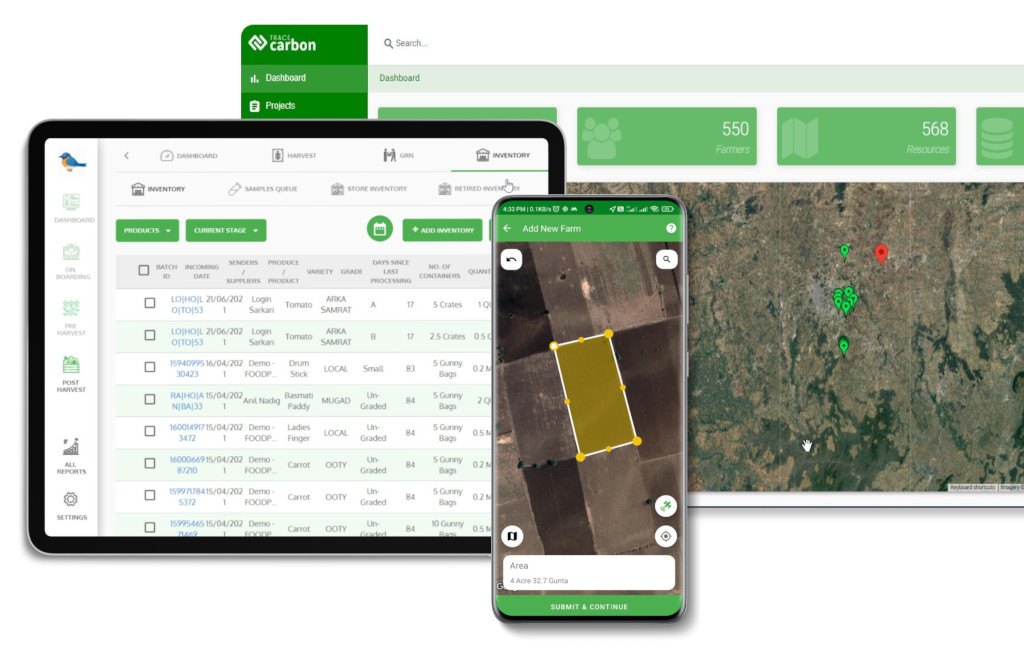Contact: +91 99725 24322 |
Menu
Menu
Quick summary: Discover how rice farmers can streamline sustainable practices with farm management solutions. Learn how real-time data, precision irrigation, and automated reporting help optimize resource use, reduce environmental impact, and ensure SRP compliance.

As the world’s demand for sustainable agriculture grows, rice farmers are feeling the pressure.
Rice farmers streamline sustainable practices by leveraging farm management solutions that optimize resource use, enhance traceability, and ensure compliance with environmental standards like SRP. These solutions provide real-time monitoring of water usage, soil health, and crop conditions, helping farmers make data-driven decisions. With automated reporting and precision irrigation, rice farmers reduce water consumption and chemical use, improving both yield and sustainability. Additionally, data integration ensures full traceability from planting to harvest, making it easier for rice farmers to meet sustainability goals while improving operational efficiency.
According to the Sustainable Rice Platform (SRP), rice uses between 30% and 40% of the world’s irrigation water for production
From reducing their environmental impact to increasing productivity and ensuring compliance with global standards like SRP, the challenges are daunting. But what if there was a way to meet these demands efficiently and profitably? Enter farm management solutions—the game-changing technology that empowers rice farmers to optimize resources, monitor farm performance, and achieve long-term sustainability.
Key Takeaways
Learn how a leading agribusiness exporter used TraceX’s farm management solutions to optimize their basmati rice production, reduce environmental impacts, and set new responsible practices standards.
Dive into the full case study to see the transformation firsthand!
Read the full case study on transforming basmati rice production
Rice farmers are those who grow rice, a fundamental food for billions, and are crucial to global food security. They encounter various challenges in their work, such as demanding physical labor, managing irrigation, and combating pests and illnesses. Regardless of these obstacles, rice farming serves as a livelihood for many, linking farmers deeply to the land.
Rice farmers face several challenges in today’s rapidly changing agricultural landscape. With rising global demand for sustainability, they are under pressure to reduce their environmental footprint, particularly in areas like water usage, carbon emissions, and soil health. At the same time, farmers must enhance productivity to meet increasing food demand, all while navigating the complexities of meeting stringent global standards such as SRP (Sustainable Rice Platform). The task becomes even more difficult with limited access to technology, data tracking tools, and sustainable practices, making it hard to balance efficiency with environmental responsibility.
1More than one-fifth of all calories consumed worldwide come from rice, the most popular cereal grain with the third-highest global production. Although Asia and some regions of Africa are good places to grow rice, it can be grown anywhere with good planning and irrigation.

Seeds are sown in prepared beds, and after 25 to 50 days, the seedlings are transplanted into fields that are surrounded by a pier that is submerged in water. Quality yield depends mainly on irrigation, the quality of seed and the quality of the soil. Rice is produced on clay, silt, or muck depending on the region and the type of climate.
Rice harvesting is a complex procedure that is done both manually and mechanically. It needs many threshing processes, which are then dried out to reduce the moisture content. The rice that has been harvested is called paddy and is now referred to as brown rice since it is covered by a hull, chaff, or husk. Additionally, milling will result in white rice grains. To give this white rice a glossy look, additional coatings with talc or glucose can be added. Many of the nutrients in brown rice are lost during this milling process which turns it into white rice.
While most of the rice that is produced around the world is used for human consumption, products of milled rice, like the bran and the rice starch are both used in brewing, distilling, fuels, fertilizer, producing oil and for livestock.
More than 60 % of the population in India is engaged in rice growing with more than 80% of them being smallholders. Climate change in the rice value chain will bring serious implications for the livelihood of these farmers and cause food insecurity.
The rice supply chain functions as a traditional multi-stage supply system. Its basic framework would include farmers as the basic suppliers of paddy, middlemen, processing industries, distributors and retailers.
Interested in learning how rice traceability and farm management solutions can enhance sustainable agriculture? Explore our blogs to discover how technology is empowering farmers to improve efficiency, sustainability, and traceability in rice cultivation.
Read our blog on Rice Traceability
Explore Farm Management Solutions for Sustainable Agriculture
Conventional rice farming often relies on continuous flooding of paddy fields, which leads to excessive water usage. Rice is a water-intensive crop, and this practice can strain water resources, especially in water-scarce regions.
The excessive use of water can result in the contamination of water bodies due to the leaching of fertilizers and pesticides. This contaminates local water sources, affecting not only the environment but also the health of nearby communities.
Continuous flooding of fields can lead to soil degradation and salinity issues, particularly in low-lying areas. Over time, the soil becomes less fertile and less suitable for rice cultivation.
Soil erosion is also a concern in conventional rice farming, especially in regions with heavy rainfall. Erosion can lead to loss of topsoil and further reduce the productivity of farmland.
Methane (CH4) emissions from flooded rice fields are a significant contributor to greenhouse gas emissions. When organic matter decomposes anaerobically in waterlogged conditions, it releases methane, which is a potent greenhouse gas.
Inefficient use of fertilizers and energy-intensive practices in conventional rice farming can also contribute to carbon dioxide (CO2) emissions.
Conventional rice farming often involves high production costs, including the expenses associated with flooding and maintaining paddy fields, as well as the cost of chemical inputs like fertilizers and pesticides.
Farmers may also incur costs related to water management, including the construction and maintenance of irrigation systems.
Small-scale rice farmers are particularly vulnerable to the challenges of conventional rice farming. High production costs can limit their ability to invest in modern agricultural practices and technology.
Market volatility and fluctuating rice prices can also pose a risk to small farmers, affecting their income and livelihoods.
Traditional rice cultivation practices, such as transplanting seedlings by hand and manual weeding, can be labour-intensive. This can lead to high labour costs and potential labour shortages during peak farming seasons.
Labor-intensive methods can be physically demanding for farmers and limit their ability to diversify into other crops or income-generating activities.
Sustainable rice farming focuses on growing rice with methods that minimize negative environmental impacts while improving productivity, conserving resources, and enhancing the livelihoods of farmers. This approach aims to reduce water consumption, cut greenhouse gas emissions, and promote biodiversity in and around rice paddies.
The System of Rice Intensification (SRI) is a methodology designed to improve the yield of rice while reducing inputs. It involves several core practices:
Benefits
Direct Seeded Rice (DSR) eliminates the need for nursery preparation and transplanting, offering a less labor-intensive and water-efficient alternative to traditional rice planting.
Benefits
Alternate Wetting and Drying (AWD) is a water-saving technique that involves periodic drying of rice fields instead of continuous flooding.

Benefits
Organic rice farming adheres to specific certification and standards to ensure that the crop is grown using environmentally friendly and sustainable practices. These standards are important for maintaining the integrity of organic products and instilling consumer confidence.
Farmers seeking organic certification must undergo a transition period during which they adhere to organic practices without using synthetic chemicals. The certification process includes documentation, on-site inspections, and adherence to the defined standards. Once certified, farmers can label their rice as “organic,” gaining access to premium markets that value sustainable and environmentally friendly agriculture. The certification and adherence to these standards provide transparency and credibility to organic rice products, benefitting both consumers and environmentally conscious farmers.
As the agricultural industry strives to meet the growing demand for sustainable practices, farm management solutions have become essential tools for rice farmers aiming to enhance both efficiency and sustainability. These digital platforms empower farmers with real-time data and advanced features that streamline decision-making and ensure that farming practices align with global sustainability standards, like SRP (Sustainable Rice Platform).
Farm management solutions are transforming how rice farmers manage their operations. By providing real-time data on critical factors like water usage, soil health, and crop conditions, these tools give farmers the information they need to make informed decisions.
This data-driven approach helps farmers optimize resources, improve crop health, and make more efficient, sustainable choices, reducing the risk of waste and enhancing productivity.
The growing need to address environmental challenges in agriculture has never been more pressing. Farm management solutions help minimize the carbon footprint of rice farming by optimizing water consumption and reducing the use of harmful chemicals. These systems monitor water usage across entire fields, enabling farmers to reduce water waste by as much as 30-40%, which is crucial in regions facing water scarcity.
Full traceability is essential for meeting the compliance requirements of SRP and other sustainability frameworks. Farm management solutions provide end-to-end traceability, documenting every step of the rice production process—from planting to harvest. This digital record includes information on field conditions, inputs used, and even water sources, making it easier for farmers to prove their practices are sustainable and environmentally responsible.
With automated reporting tools integrated into the platform, farmers can easily generate and submit the necessary documentation for SRP certification. This ensures transparency and compliance, easing the burden of regulatory reporting and allowing farmers to focus more on growing crops and less on paperwork.
One of the most powerful features of farm management solutions is their ability to provide automated monitoring and real-time alerts. These systems track key metrics—such as soil moisture levels, pest activity, and weather conditions—and send instant notifications when something goes wrong. For example, if the soil moisture falls below optimal levels, the system will alert the farmer, prompting them to take immediate action, such as activating the irrigation system or adjusting fertilizer application.

TraceX offers a suite of farm management solutions designed to streamline the entire farming process, empowering farmers to optimize productivity, ensure sustainability, and meet industry-specific standards, such as SRP (Sustainable Rice Platform). The platform combines cutting-edge technology, data analytics, and automation to provide farmers with comprehensive tools for managing their operations more effectively and sustainably.
TraceX ensures that traceability is a core feature of its platform. From planting to harvesting, farmers can track every step of the farming process, ensuring full visibility into their supply chain. The platform provides tools to capture data on:
This level of traceability not only helps with compliance to sustainability standards like SRP but also provides clear documentation to consumers, regulatory bodies, and supply chain partners.
TraceX offers tools to manage the entire supply chain, from field to fork. It tracks each batch of rice (or other crops) through its journey, ensuring that sustainability claims are verifiable at every stage. This includes managing supplier relationships, tracking shipments, and ensuring that ethical sourcing is maintained throughout.
TraceX’s platform provides actionable data insights that help farmers and agribusinesses make informed decisions. By analyzing historical and real-time data, farmers can identify trends, forecast yields, and make more accurate business decisions related to planting schedules, crop rotation, and sales strategies.
In conclusion, sustainable rice cultivation is not just a farming method; it’s a commitment to a healthier planet and a more prosperous future. By embracing practices like efficient water management, biodiversity preservation, and responsible soil health maintenance, we can reduce the environmental impact of rice farming, increase yields, and improve the well-being of farmers and their communities. The adoption of innovative technologies and a shift in mindset toward eco-conscious agriculture are paving the way for a more sustainable and resilient rice industry. As we face the challenges of climate change, resource scarcity, and food security, sustainable rice cultivation offers a path forward, one that allows us to nourish our growing global population while protecting our precious natural resources and ensuring a greener, more sustainable future.
Want to learn more about Sustainable Rice Platform (SRP), digital transformation for sustainability, and mastering farm management? Dive into our expert blogs to discover how technology can drive sustainability, improve productivity, and ensure environmental responsibility in rice farming.
Read our blog on Sustainable Rice Platform (SRP)
Explore Digital Transformation for Sustainability
Get our Guide to Farm Management for Sustainable Agriculture
Farm management solutions provide real-time data on water usage, soil health, and crop conditions, helping rice farmers optimize irrigation, reduce chemical use, and minimize waste, leading to a significant decrease in their environmental footprint.
Key features include real-time monitoring, precision irrigation tools, automated compliance reporting, traceability for sustainable practices, and data-driven decision-making to improve efficiency and ensure SRP compliance.
By offering insights on resource optimization, monitoring crop health, and automating processes like irrigation and fertilization, farm management solutions help rice farmers increase productivity while maintaining sustainability and reducing operational costs.
